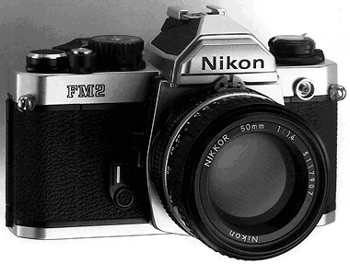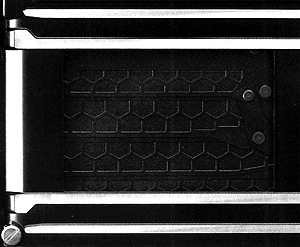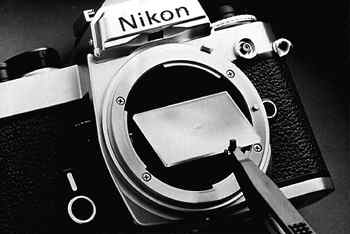| The Modern Classics |
Nikon FM-2 |
| In 1982 Nikon caused a sensation: the FM was modified and received a shutter with a fastest speed of 1/4000 sec. - the FM-2 became the world record holder. But that was not enough: as a spin-off - although many consider it to be the main argument for the camera - this shutter is capable of a fastest sync-speed of 1/200 sec., and later, in the FM-2n of a 1/250 sec. |
 |
| The FM-2: in spite of its high-performance shutter the body dimensions remained unchanged. |
| Shutter speeds can be increased to a certain degree by reducing the width of the slit between the two blinds, but a faster sync-speed can only be achieved by increasing the shutter`s running speed because it must stay completely open for about 1/1000 sec. when an electronic flash is employed. Nikon managed to realize both demands in cooperation with Copal, the manufacturer of the shutter. |
| To do so, this advanced mechanical construction accelerates the shutter blinds to an average speed of about 25 km/h. This becomes especially impressive when you realize that the start, the acceleration phase, and the retardation take place within a mere 24mm. Nikon developed shutter blades made of extremely light and mechanically sturdy titanium foil into which a honeycomb pattern was etched in order to further decrease their weight and increase their stiffness. |
| This allowed the weight of the blades to be reduced by nearly 60%. The mass of a normal shutter blind accelerated at this rate would have caused vibrations that would probably have prevented any sharp picture. |
 |
| A world record at the time: 1/4000 sec. with the FM-2. |
|
Background information: The Shutter The shutter has the job of allowing the film to be exposed for a certain time that can be reproduced repeatedly. In the early days of photography this was done by removing and replacing the lens cap, since the plates employed then demanded exposures of at least several minutes. As film materials became more sensitive exposure times were reduced to seconds and towards the end of the last century they reached fractions of a second. Of course, this could no longer be controlled with the lens cap. The first shutters for photographic cameras appeared in the 1890's and mass-produced shutters at the beginning of this century. These were lens shutters, the most common construction having curved leaves (the shutter blades) cover the shutter port. When released these blades are rotated around a fixed axis by the power of a spring so that the port is opened from the centre. Lens shutters uncover the complete frame at every speed so that they can be flash synchronized at any speed. However, due to their inertia, speeds are only possible up to 1/500 sec. Another disadvantage for system cameras with interchangeable lenses is that such shutters have to be integrated into the lenses. This restricts the maximum aperture, and also means that if you have five lenses you also have five shutters. An advanced type of lens shutter which is mainly employed in medium and large format lenses today can be found in modern AF-viewfinder cameras, where the blades do not always open completely and so also take over the diaphragm`s function. In 35mm SLR cameras focal plane shutters within the body are employed without exception. The main parts of these shutters consist either of two roller blinds of rubberized fabric (Nikon I, S and M), or especially in Nikon`s case, of titanium foil (Nikon SP, F - F3). As of the Nikkormat series jointed metal strips (blades) were employed instead of the roller blinds (FT - FT-3, EL/EL-2, FM - FA, EM - FG, F-301 - F-801s, F4) which occupy much less room in the body than roller blind shutters. During the exposure these blinds or blades travel across the film window at a constant speed. The exposure duration is determined by the width of the slit between the blinds. A narrow slit of only a few millimetres represents a short exposure, the longer the exposure, the wider the slit. The exposure takes place in strips, so to say. In the F3 a blind takes about 10ms (1/100 sec.) to travel from one end to the other. At a shutter speed of 1/2000 sec. the slit is just under 2mm wide. In the Nikon F the shutter travels across the film window`s 36mm at almost 11km/h. An impressive achievement at that time considering that the complete operation, starting in the initial position through acceleration to retardation and back again, takes place over a distance of less than four centimetres. But in the FE-2 the blades whizz across the shorter stretch of 24mm at more than 28 km/h from top to bottom. There are several reasons behind the engineers` efforts to increase the shutter`s operating speed: 1. The sync-speed. Modern electronic flash units, with the exception of studio systems, cannot achieve a light output longer than about 1/1000 sec. even at full power. When used together with focal plane shutters a flash unit can only be triggered after the first blind has completely travelled across the film window and the second has not yet moved. For example, the Nikon F`s blind takes 12ms to do so. If you add 0,5ms margin and a flash duration of 1ms, the result is about 14ms between the beginning of the exposure and the earliest possible starting time for the second blind. So, the shortest X-sync-speed has to be longer than 14ms. At 1/60 sec. (equalling 16,6ms) this is the case. Anyone can imagine how precise the shutter must work at a sync-speed of 1/250 sec.. 2. The width of the slit. In the course of the exposure the entering light is subject to diffraction at the shutter blind edges, which may cause the same kind of degradation in image quality as the diaphragm blades. The narrower the slit, the higher the degree of diffraction. In the FE-2 the slit is 2mm wide at a shutter speed of 1/4000 sec. which only results in a tolerable amount of diffraction. If the slit in the F were to be narrowed down in order to achieve a shutter speed of 1/4000 sec. it could be no wider than 0,75mm. The degree of diffraction would be so high that the negative would turn out unsharp in spite of the extremely short exposure. 3. Image distortion. If you photograph a moving subject, it will travel a certain distance during the exposure. For example; if a motorcycle travelling at a speed of 100 km/h is photographed from the side with a Nikon F and a shutter speed of 1/1000 sec., it will cover a good 30cm during the shutter`s 12ms operating time. Not much at first sight, but in certain situations, for example a football flying past being captured with a long telephoto lens, this effect can become evident. Subjects moving in the opposite direction to the travel of the shutter blinds will be compressed, subjects moving in the same direction will be stretched. What will the future bring us in terms of shutter design? Much higher speeds do not seem to be possible with mechanical designs. Constructions employing liquid crystal technology are feasible. In such a shutter the blinds would be replaced by a liquid crystal plate which, reacting to electrical signals, can turn from translucent to transparent within fractions of a second and so expose the film. |
| Since 1989 the FM-2 has been equipped with the F-801 shutter blinds. Many other things have also been modified in the FM-2, keeping in mind the more conservative photographers who still miss the purely mechanical F2. At last the FM-2 also allows the focusing screens to be changed, first those of the FE were used, later the FE-2 brighter versions. The mirror mount, now made of titanium, and its retarder were also changed. The film transportation mechanism is now mounted in five ball-bearings. The film speed dial was enlarged and the film speed setting range extended up to ISO 6400/39°. The metering cells employed are SPD-photodiodes that work three times as fast as the type formerly used. The first special click-stop X-position of the FE-2 was a slight mishap because the metering system is switched off in this position. This was a handicap especially in fill-in flash situations when a fast sync-speed is really necessary. Luckily this shortcoming was eliminated in the FM-2n. Known only to few and no problem in everyday use, the first FM-2 also allowed the use of the 1/250 sec. in combination with a flash unit. Some photographers may have been stopped or at least irritated by the winking flash-ready light that seemed to indicate a malfunction. |
 |
| Changing the focusing screen through the bayonet with the help of the special tweezers. |
| The metering symbols are LEDs now. Metering is activated for about 30 seconds by pressing the release button. The multiple exposure lever is situated directly beneath the advance lever as in the FE. The release button itself was enlarged so that only cable releases with an ISO-type thread can be employed. A fundamental restriction is that because its AI-coupling lever cannot be folded away, non-AI standard lenses cannot be used on the FM-2. Two gold-plated contacts are located under the FM-2 film guide rails in order to control the databack MF-16. |
| back to Nikon COMPENDIUM main page |